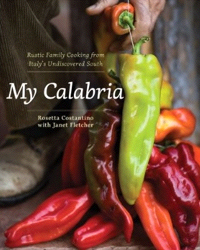Just as Fabio Trabocchi‘s Cucina of Le Marche (See Super Chef‘s review) brought the rich a varied cooking of a lesser-known part of Italy to American readers. Rosetta Costantino‘s My Calabria: Rustic Family Cooking from Italy’s Undiscovered South (Norton 2010) does the same.
Co-authored with Janet Fletcher, My Calabria tours the food of the mountainous toe of Italy, where southern Italian food is at its simplest and most varied:
Simplicity is the cuisine’s hallmark, resourcefulness the Calabrian cook’s signature and strength. The food is bold and substantial, and it speaks directly to hunger. In its artlessness, it is the opposite of the refined and baroque cooking of Emilia-Romagna. (p. 2)
The book starts with a long gastronomic tour of the region (“Un Viaggio Virtuale in Calabria”) that will make you want to book a flight for the holidays. “Sheep thrive around Spilinga and the gentle hills to the east, providing milk for the highly regarded Pecorino del Monte Poro and ricotta. The aged pecorino, hard enough to grate, makes an easily packable and nonperishable souvenir.” (p. xvii) (Rosetta does run her own culinary tours of Calabria.)
Rosetta recalls her own childhood in Calabria where h family were farmers, and then a move to California for a brighter future. She covers Calabrian ingredients that are slightly different then those from Northern Italy, such as Salt Cod and Wild Fennel Seed. The Antipasti are vaguely reminiscent of the flavors of Sardinia in Efisio Farris‘ Sweet Myrtle & Bitter Honey: The Mediterranean Flavors of Sardinia (See Super Chef‘s review).
 If you have access to fresh, uncured olives, there are several olive recipes, like Olive Verde Schiacciate (pp. 24-26) that are cured olives with fennel and hot red pepper, and Fave Arrappate (pp. 29-30 that is a combination of fava beans and dry-cured olives. Tartine al Burro di Bottarga (p. 42) is a simple crostini with pressed dried tuna row and butter.
If you have access to fresh, uncured olives, there are several olive recipes, like Olive Verde Schiacciate (pp. 24-26) that are cured olives with fennel and hot red pepper, and Fave Arrappate (pp. 29-30 that is a combination of fava beans and dry-cured olives. Tartine al Burro di Bottarga (p. 42) is a simple crostini with pressed dried tuna row and butter.
Pizza in Calabria is pitta, stuffed dough filled with greens like Swiss chard, dill, and scallions in the Pitta con Verdura (p. 131-3) . There are excellent photos by Sara Remington that show how to layer dough and filling. There are other pitta recipes like Pitta Mijina (pp. 140-142) that calls for a cornmeal crust and a cabbage stuffing. Rosetta explains how to make fresh Ricotta, which her father made on his farm in Calabria.
There is more to explore in My Calabria, like the wonderful salumi, seafood, and desserts, including Chinulille, Sweet Ravioli with Ricotta and Candied Orange (p. 322). Cookbook and guidebook, My Calabria opens up a new area of Italy – but, be forewarned – you will definitely feel the urge to jump on the next plane to Italy.
RECIPE Pitta Mijina
Cornmeal Flatbread Cooked on a Cabbage LeafIngredients:
2 cups (10 ounces/200 grams) fine white or yellow cornmeal
2 teaspoons kosher salt
1 3/4 cups (625 milliliters) boiling water
1/4 cup (60 milliliters) warm water (104 to 110 degrees F/ 45 degrees C)
2 teaspoons active dry yeast
1 cup (5 ounces/140 grams) unbleached all-purpose flour
1 large outer leaf of Savoy cabbage, at least 12 inches (30 centimeters) in diameter, left at room temperature for one day to wild, optional
1 garlic clove, halved
Ground hot pepper
Calabrian paprika (page 304) or Spanish sweet paprika
3 tablespoons extra virgin olive oil
6 anchovy fillets, or to tasteIn a large bowl, stir the cornmeal and salt to blend. Add the boiling water and stir until the cornmeal is thoroughly moistened. Set aside until cool.
Put the warm water in a small bowl. Sprinkle the yeast over the water and let stand for a minute to soften. Whisk with a a fork until the yeast dissolves.
Add the flour and dissolved yeast to the cornmeal. Mix with your hand until the ingredients come together into a well blended but sticky dough. Cover the bowl tightly with plastic wrap and let rise until the dough has doubled, about 1 1/2 hours.
Line the lowest rack with baking tiles or a baking stone. Preheat the oven to its highest setting, at least 525 degrees F (275 degrees C) if possible.
On a pizza peel or rimless baking sheet, place the flattened cabbage leaf, if using, or place a sheet of parchment paper about 12 inches (30 centimeters) square. Dust the parchment lightly with flour. The cabbage leaf does not need flour.
TUrn the dough out onto the cabbage leaf or parchment paper and prod it with moistened fingertips into a flat 10-inch (25-centimeter) circle. With one moistened fingertip, make about a dozen evenly spaced dimples in the dough, poking almost but not all the way through.
Slide the pitta onto the preheated tiles or baking stone and bake until golden brown and firm on both top and bottom, about 15 minutes. Use the pizza peel or rimless baking sheet to transfer the pitta to awork surface, do not turn off the oven. Peel off the cabbage leaf or parchment paper. Rub the surface of the pitta all over with the cut side of the garlic halves. Sprinkle generously with hot pepper to taste and paprika, then drizzle with olive oil. Tear the anchovy fillets into 1/4- inch (6 millimeter) pieces and sprinkle them evenly over the surface.
Return the pitta to the oven until it is again piping hot, about 3 minutes. Cut into wedges and serve immediately.
Makes one 10-inch (25-centimeter) pitta, to serve 8 to 10 as an appetizer.

2 comments on “Rosetta Costantino: My Calabria”